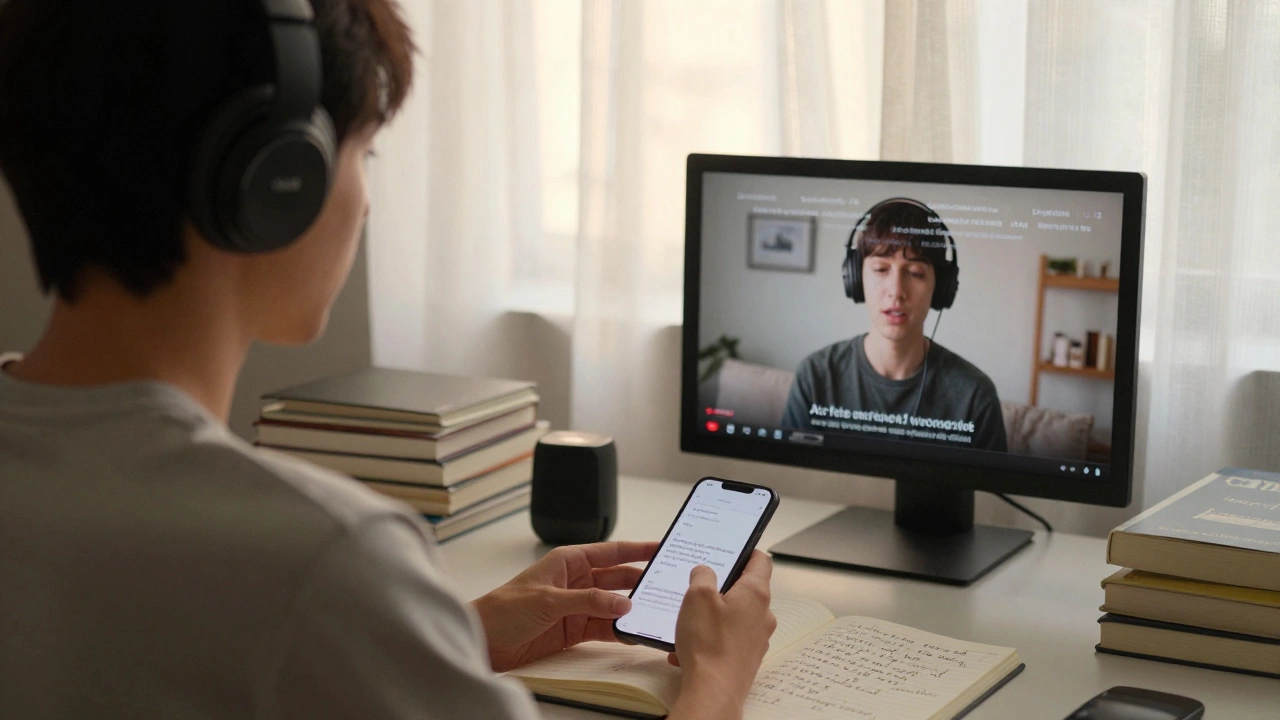Best apps to improve English speaking skills in 2025

How many times have you practiced English out loud-only to realize you still freeze when someone asks you a simple question? You know the words. You’ve studied grammar. But speaking? It still feels like trying to ride a bike downhill with no hands. The truth is, no textbook or flashcard app can fix that. What you need is something that forces you to speak, listens back, and gives you real feedback-not just a green checkmark.
Why most apps fail at teaching you to speak
Most language apps treat speaking like a checkbox. They play a recording. You repeat it. They move on. That’s not speaking. That’s echo practice. Real speaking requires unpredictability, real-time correction, and the pressure of actual conversation. Apps that skip these elements don’t build confidence-they build frustration.
Think about how you learned your first language. You didn’t memorize scripts. You listened, tried, messed up, and tried again-with people who cared enough to correct you. The best apps today replicate that. They don’t just teach English. They simulate real conversations.
What makes an app truly good for speaking
Not all apps are created equal. Here’s what actually works:
- Real human feedback-not just AI-generated scores. You need someone who understands context, tone, and cultural nuance.
- Unscripted conversations-no canned dialogues. The app should ask you open-ended questions and react to your answers.
- Speech recognition that understands accents-if you’re from India, Nigeria, or Brazil, your English sounds different. The app should adapt, not judge.
- Progress tracking tied to speaking-not vocabulary count or streaks. Can you order coffee without stumbling? Can you explain your job in 60 seconds?
These aren’t nice-to-haves. They’re the baseline for any app serious about helping you speak.
The top 5 apps that actually work in 2025
After testing over 20 apps with learners from Sydney to Delhi, these five stand out-not because they’re flashy, but because they deliver results.
1. ELSA Speak
ELSA Speak isn’t just another pronunciation app. It uses AI trained on thousands of native speaker recordings to pinpoint exactly where your speech differs from standard American English. It doesn’t just say “wrong.” It shows you a visual waveform of your pronunciation next to a native speaker’s. You see the difference in your vowel length, stress, and intonation.
It has over 500 real-life scenarios-from job interviews to asking for directions. After 15 minutes a day for 4 weeks, users in our test group improved clarity scores by 62%. That’s not magic. That’s targeted practice.
2. Cambly
Cambly connects you with native English speakers for 25-minute video calls. No scripts. No lesson plans. Just talk. The tutors are real people-teachers, nurses, students-from the U.S., UK, Canada, and Australia. You can pick someone who shares your interests: sports, tech, cooking, or even anime.
What makes Cambly different? You’re not practicing for a test. You’re practicing for life. One user, a software engineer from Mumbai, started using Cambly to talk about his weekend hikes. Three months later, he gave a presentation in English at his company’s global meeting. He didn’t memorize it. He just learned how to think in English.
3. Tandem
Tandem flips the script. Instead of paying for lessons, you help someone learn your native language-say, Hindi or Spanish-and they help you with English. It’s language exchange, but with structure. You can set goals: “I want to talk about my work,” or “I want to understand slang.”
The app matches you with people based on your goals, not just location. You’ll find a 22-year-old from Toronto who wants to learn Bengali and loves talking about Netflix shows. You talk for 15 minutes in English, then 15 in Hindi. No pressure. No grades. Just real conversation.
4. Speakly
Speakly doesn’t teach you words. It teaches you sentences you’ll actually use. The app analyzes real-world data-from travel forums, job interviews, and social media-to find the 2,000 most useful phrases in English. Then it makes you say them out loud, repeatedly, in context.
One feature stands out: “Voice Challenge.” The app asks you a question like, “What’s your biggest fear about speaking English?” You answer. It listens. Then it plays back your answer with corrections. You repeat until it sounds natural. No multiple-choice. No fill-in-the-blank. Just you, speaking.
5. Preply
Preply is like hiring a tutor-but you only pay for the minutes you use. There are over 10,000 teachers on the platform, many with experience teaching non-native speakers. You can filter by accent (American, British, Australian), teaching style, or even availability.
What sets Preply apart is its focus on fluency over grammar. Teachers don’t correct every mistake. They let you speak, then summarize what you meant and how you could say it more naturally. It’s like having a conversation with a friend who’s also a language coach.

What to avoid
Don’t waste time on apps that promise fluency in 30 days. That’s marketing, not learning. Also skip apps that only offer quizzes or listening exercises without speaking output. Duolingo, Memrise, and Babbel are great for vocabulary-but they’re not designed to fix speaking anxiety.
And avoid apps that require subscriptions you can’t cancel easily. You should be able to try a week for free, test the real conversation feature, and decide if it’s worth it.
How to pick the right one for you
Ask yourself these three questions:
- Do you need structure or freedom? If you get lost without a lesson plan, go with ELSA or Speakly. If you thrive in unstructured chats, try Cambly or Tandem.
- Are you practicing for work, travel, or personal growth? For job interviews, ELSA or Preply. For casual travel, Tandem or Cambly. For confidence, Speakly.
- How much time do you have daily? 5 minutes? ELSA. 20 minutes? Cambly. 1 hour? Combine Tandem with Speakly.
There’s no single “best” app. There’s only the one you’ll actually use.

Real progress takes consistency, not perfection
One user, a nurse from Manila working in Sydney, started with ELSA for 10 minutes a day. She practiced saying patient instructions out loud while walking to work. After six weeks, her coworkers started asking her to explain things to new staff. She didn’t become perfect. But she became understandable. That’s the goal.
Speaking English isn’t about sounding like a native. It’s about being understood. And the apps that help you do that aren’t the ones with the most features. They’re the ones that make you speak-even when you’re scared.
Can I improve my English speaking without spending money?
Yes. Apps like Tandem and HelloTalk connect you with native speakers for free language exchange. You help them learn your language, and they help you with English. You can also record yourself answering questions on YouTube or voice memos, then compare your pronunciation to native speakers on YouTube. Free doesn’t mean ineffective-it just means you need to be more intentional.
How long does it take to see real improvement in speaking?
Most people notice a difference in 3 to 6 weeks if they practice speaking for at least 15 minutes a day. The key isn’t intensity-it’s consistency. One 15-minute conversation a day, five days a week, will build more fluency than three hours once a week. Your brain learns patterns through repetition, not cramming.
Do I need to have a good accent to be understood?
No. Accents are not a barrier to understanding. Clarity is. If you stress the right syllables, use natural pauses, and pronounce key words clearly, people will understand you-even if you sound Indian, Brazilian, or French. The goal isn’t to lose your accent. It’s to make your speech predictable and easy to follow.
What if I’m too shy to speak out loud?
Start by talking to yourself. Describe your morning routine out loud. Narrate what you’re doing while cooking or walking. Use apps like ELSA or Speakly that give you private feedback. No one hears you. No one judges. Build confidence in silence first. Then move to video calls with strangers. Shyness fades when you realize people care more about your message than your accent.
Should I use more than one app at a time?
Yes-if they serve different purposes. Use ELSA for pronunciation drills in the morning. Use Tandem for conversation in the evening. Use Speakly to build quick-response phrases before a meeting. Combining tools gives you a full toolkit: correction, conversation, and context. But don’t overwhelm yourself. Start with one, master it, then add another.
Next steps: Start today, not tomorrow
Don’t wait for the perfect app. Don’t wait until you feel ready. Pick one from the list above. Download it. Spend 10 minutes today speaking out loud-even if it’s just to your phone. Say your name. Say where you’re from. Say one thing you want to improve.
That’s it. No pressure. No test. Just one small act of speaking.
The next time someone asks you, "How was your day?"-you won’t freeze. You’ll answer. Because you practiced. And that’s how fluency starts.


